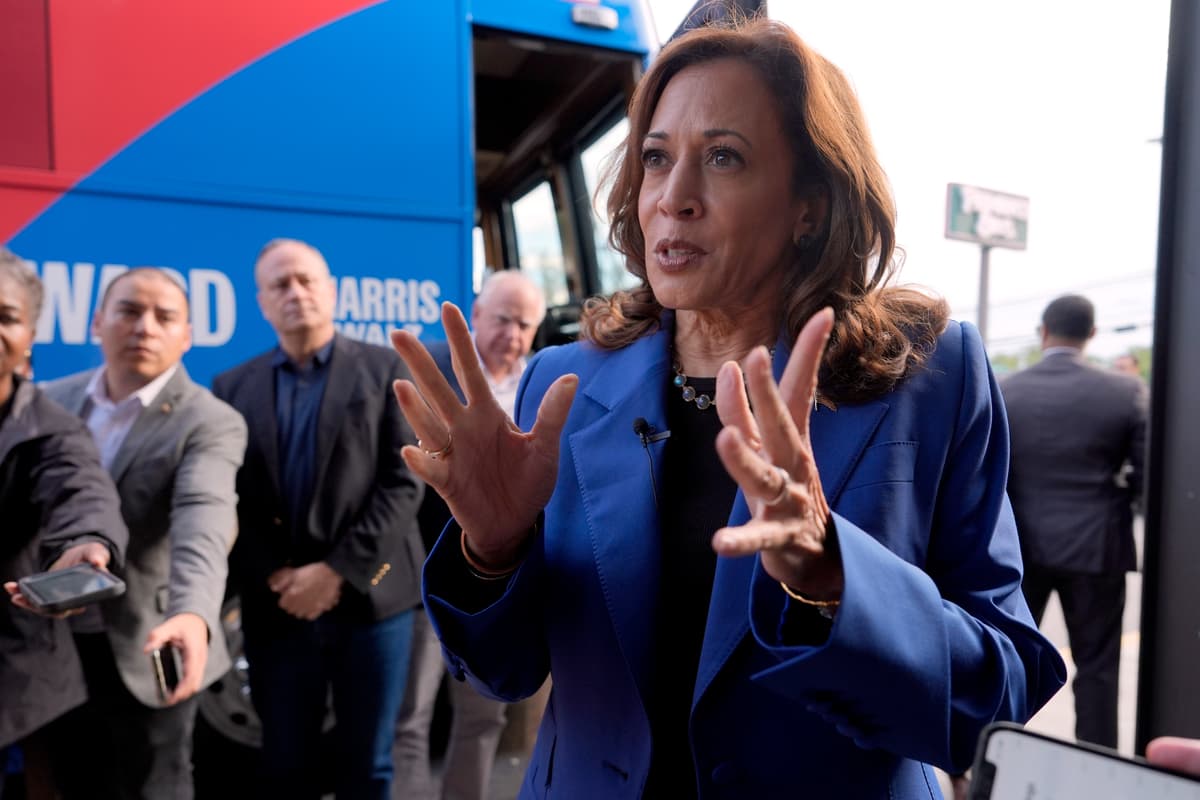Harris Could Need a Campaign Strategy Reset To Reassure Voters Afraid That She Is ‘Super Liberal’
‘The general worry among some Democrats is that she’s not trying to address these concerns,’ one analyst warns.

In my time as a political consultant, I observed that carrying out a campaign strategy was surprisingly simple. You settled on a basic strategy, emphasizing the candidate’s strong points on issues and character, framing the election in terms favorable to most voters. Then you just carried it out.
Almost always, events would intrude — campaign gaffes, unfavorable public polls, press controversies, surprise initiatives by the opposition. At such points, you’d get lots of advice, from inside and outside the campaign, about how you had to change course and do things differently.
The hard part was distinguishing between the nine times out of ten in which you should, diplomatically if possible, ignore such advice and stick to the strategy, and the one time out of ten when you should change course.
Looking on from afar, I think there’s a good chance Vice President Harris’s campaign has reached such a point.
Much of Ms. Harris’s strategy from President Biden’s withdrawal on July 21, and even before, was obvious: Emphasize President Trump’s character flaws, build on Democratic voters’ enthusiasm that they were no longer stuck with a sure loser, show off the best candidate’s smile since President Reagan’s.
The hard part was dealing with issues. The Biden-Harris record on inflation and immigration is highly unpopular. Beyond that, on her own as a candidate for the 2020 Democratic presidential nomination, Ms. Harris had taken a number of “woke” positions on issues that are not shared by anything like a majority of general election voters.
Banning fracking, a major industry in Pennsylvania. Decriminalizing illegal border crossing. Abolishing non-government health insurance. A mandatory buyback — i.e., confiscation — of so-called assault weapons. Major cuts in funding for Immigration and Customs Enforcement. Government-paid gender transition surgery for detained illegal immigrants.
How to deal with these now-inconvenient facts? The Harris strategy has been to sweep them aside. Focus, as the candidate of change, on the future. “We can’t afford four more years of this,” her running mate, Governor Walz, bellowed at a Bethlehem, Pennsylvania, rally last weekend.
As for those inconvenient issue stands, have a staffer quietly tweet that they’re now, in President Nixon’s press secretary Ron Ziegler’s term, “inoperative.”
Otherwise, hide the candidate — and trust a mostly sympathetic press, something like 90 percent of whose members want to see Trump lose, not to press hard on any subject that might not help the campaign.
As my Washington Examiner colleague Byron York has noted, many journalists are unashamedly, even delightedly, determined not to disclose Ms. Harris’s positions on issues lest they help Trump.
This has mostly seemed to work. In the single interview on August 29 that Ms. Harris submitted to in her first month as presidential candidate, with Mr. Walz included, CNN’s Dana Bash did ask her to explain her changes on issues. “My values haven’t changed,” Ms. Harris said, not responding to the question.
Ms. Bash did not follow up in what was, bafflingly, a brief interview. The candidate didn’t have more than a half-hour a month for interviews? In her single debate with Trump on September 10, Ms. Harris was only a bit more forthcoming. “What I have seen is that we can grow and we can increase a clean energy economy without banning fracking,” Ms. Harris replied.
This strategy has worked, up to a point. Poll averages two weeks after the debate show Ms. Harris a couple of points ahead of Trump nationally, and competitive in target states. Poll analyst Nate Silver’s model Monday gave her a 53 percent chance of winning the Electoral College.
Only that’s well below the 71 percent chance it gave Senator Clinton just before the 2016 election. The RealClearPolitics average of recent polls shows Trump at least 1 percent ahead in states with 246 electoral votes, Ms. Harris that far ahead in states with 226.
There are signs that Team Harris may be nervous about the risks in their strategy. Ms. Harris is apparently doing interviews with sympathetic press — local public radio, liberal bloggers — which could result in embarrassing excerpts.
Independent analyst Mark Halperin perceives a more pessimistic outlook among Democratic strategists than public polls suggest, particularly over what specifically she would do as president and whether she’s “super liberal.”
“The general worry among some Democrats is that she’s not trying to address these concerns,” Mr. Halperin said in a recent livestream on the YouTube channel 2WAY.
There’s a clear strategy here for Republicans: Fill in the blanks. Ms. Harris’s strategy left 28 percent of voters in the New York Times-Siena September 3-8 survey saying they “felt they needed to know more” about Ms. Harris compared to only 9 percent for Trump. Republicans have less money than Democrats, but they can still run barrages of TV ads highlighting Ms. Harris’s previous liberal positions and questioning whether she’s going to pursue them once she’s elected.
There’s video of her support for government-paid inmate transgender surgeries, which prompted an embarrassing correction by Time and an unacknowledged error by the normally well-informed Susan Glasser in the legendarily fact-checked New Yorker. And the Daily Mail just unearthed video of Ms. Harris chanting, “Down, down with deportation,” with hate hoaxer Jussie Smollett.
The existence of such evidence is not an accident. As Washington Post columnist Megan McArdle explains, it’s part of “an ongoing pattern in which Democratic politicians endorse, explicitly or implicitly, policies so extreme that if you reference them even Democratic political junkies will accuse you of making them up.”
Commenters on Ms. McArdle’s article on the Post website heatedly insist that the positions she cites aren’t really extreme or should be popular if people were enlightened, or something — effectively confirming her thesis.
This sort of thing has happened before. In 1988, as Post columnist Richard Cohen reported, a much more serious practitioner of public policy than Ms. Harris, Michael Dukakis, lost his huge poll lead in part because of ads pointing out that for 11 years, he had supported a policy of releasing on weekend furloughs prisoners who had been sentenced to life without parole.
Democratic strategists and much of the press tried to ignore the issue or dismiss the ads as racism. The better strategy would have been an early confession of error and a promise to avoid such extreme stands in the future.
Ms. Harris’s strategists rejected that strategy back in July and hoped they could glide to victory on joyful vibes and with the help of a press determined not to ferret out any inconvenient truths.
Now, six weeks out and with odds not significantly better than 50/50, they seem to be wondering whether this is one of the nine out of ten times when they should not change their strategy, or the one out of ten times when they should.
Creators.com

